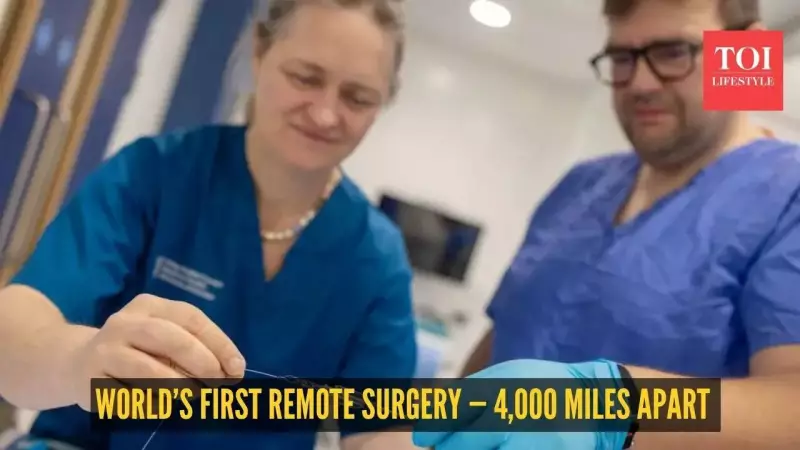
In a historic medical breakthrough that sounds like science fiction, a team of doctors from Scotland and the United States has successfully performed what is believed to be the world's first transatlantic robotic surgery for stroke. This pioneering procedure, conducted on a human cadaver, could fundamentally change how emergency stroke care is delivered, especially in remote and underserved areas.
A Groundbreaking Transatlantic Operation
The medical milestone unfolded in two parts. First, Professor Iris Grunwald, a leading interventional neuroradiologist, performed a remote thrombectomy from her base at Ninewells Hospital in Dundee, Scotland. She operated a robotic system that was connected to a body located in a separate facility miles away.
Just hours later, the experiment reached a new pinnacle. Dr. Ricardo Hanel, a neurosurgeon based in Jacksonville, Florida, took control of the system. He performed the world's first transatlantic remote surgery on a human cadaver located in Dundee, covering a staggering distance of over 4,000 miles (6,400 km).
Both procedures were powered by robotic systems developed by the Lithuanian firm Sentante. The crucial connectivity that made the long-distance operation possible was provided by technology giants Nvidia and Ericsson.
A Potential "Game Changer" for Stroke Care
The team has hailed the experiment as a potential "game changer" that could redefine global stroke treatment protocols. "It felt as if we were witnessing the first glimpse of the future," said Prof. Grunwald. "Where previously this was thought to be science fiction, we demonstrated that every step of the procedure can already be done."
The project was carried out at the University of Dundee, which serves as the global training center for the World Federation for Interventional Stroke Treatment. It is also the only location in the UK where doctors can practice procedures on cadavers with a liquid that mimics human blood flowing through the vessels.
"This was the first time that we could perform the whole mechanical thrombectomy procedure in a real human body to show that all steps of the procedure are possible," Grunwald explained, underscoring the significance of the achievement.
Juliet Bouverie, Chief Executive of the Stroke Association, echoed this sentiment in an interview with BBC News, calling the experiment "a remarkable innovation." She highlighted its immense potential to close the critical treatment gap for patients in remote and rural regions. "For too long, people living in remote and rural areas have been deprived of access to thrombectomy," she stated. "Robotics like this could rebalance the inequity which exists in stroke treatment across the UK."
How the Remote Robotic Thrombectomy Works
A thrombectomy is the gold-standard treatment for an ischemic stroke, which occurs when a clot blocks an artery and cuts off oxygen to the brain. However, access to the highly specialized surgeons who can perform this intricate procedure remains severely limited.
This experiment demonstrated a revolutionary solution. A robot can be connected to standard catheters and wires, allowing a surgeon anywhere in the world to manipulate the instruments remotely. A medic physically present with the patient only needs to attach the wires. From that point onward, the remote surgeon can perform the entire operation via a robotic console, watching live X-rays and guiding every instrument motion in real time.
Remarkably, Professor Grunwald noted that it took just 20 minutes of training to learn how to control the robotic system effectively.
Dr. Hanel, who executed the long-distance segment from the US, was impressed by the system's responsiveness despite the vast distance. "To operate from the US to Scotland with a 120 millisecond lag, a blink of an eye, is truly remarkable," he commented.
Closing the Global Stroke Care Gap
The success of this procedure tackles two of the most pressing challenges in modern stroke care: a critical shortage of specialists and the stark inequality in access to treatment based on a patient's geographic location.
"The treatment is very time sensitive," Prof. Grunwald emphasized, pointing to a chilling statistic. "Every six minutes delay, you have a 1% less chance of having a good outcome. This technology would now provide a new way where you're not depending on where you live, saving the valuable minutes where your brain is otherwise dying."
The data underscores the urgency. Public Health Scotland reported 9,625 ischemic strokes in the country last year. Out of these, only 212 patients (2.2%) received a thrombectomy. The figure for the rest of the UK was only slightly better, at 3.9% as of March 2024.
Edvardas Satkauskas, CEO of Sentante, told BBC News that the results represent a significant leap forward in tele-robotic surgery. "It feels amazing," he said. "Sometimes, the future is way closer than we think."
With clinical trials on living patients expected to begin next year, researchers are optimistic. What started with a robotic arm in Dundee and a surgeon in Florida could one day mean that a stroke patient in the Scottish Highlands, or in any remote corner of the world, can access life-saving treatment within minutes, not hours.





